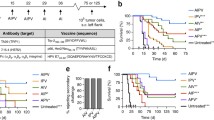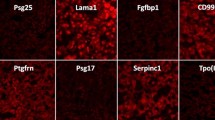Abstract
We show here that in contrast to BALB/c mice bearing a late-stage, large MOPC-315 plasmacytoma, BALB/c mice bearing a late-stage, large RPC-5 plasmacytoma were not cured by cyclophosphamide therapy (15, 50, 100 or 200 mg/kg). However, most BALB/c mice bearing a late-stage RPC-5 tumor were cured by cyclophosphamide therapy (100 mg/kg) in conjunction with adoptive immunotherapy using tumor-infiltrated spleen cells (TISpC) that had been cultured with inactivated RPC-5 tumor cells plus polyethylene glycol 6000, even though this protocol was not effective for the therapy of mice bearing a barely palpable, early-stage RPC-5 tumor. Only a few of the mice that were cured of a late-stage RPC-5 tumor following adoptive chemoimmunotherapy (ACIT) were resistant to a subsequent challenge with RPC-5 tumor cells. However, the challenged mice that had developed progressively growing tumors could then be cured by cyclophosphamide alone when the tumor became large, even though this treatment was not curative for mice bearing a tumor of similar size but not previously treated by ACIT. Thus, the cure by ACIT of BALB/c mice bearing a lethal, late-stage RPC-5 tumor with extensive metastases provides a novel experimental tumor model for investigating the mechanisms by which a chemotherapeutic drug and adoptive cellular immunotherapy can cooperate in causing the complete regression of a large tumor load.
Similar content being viewed by others
References
Barth Jr RJ, Bock SN, Mule JJ, Rosenberg SA (1990) Unique murine tumor-associated antigens identified by tumor infiltrating lymphocytes. J Immunol 144: 1531
Ben-Efraim S, Bocian RC, Mokyr MB, Dray S (1983) Increase in the effectiveness of melphalan therapy with progression of MOPC-315 plasmacytoma tumor growth. Cancer Immunol Immunother 15: 101
Cheever MA, Greenberg PD, Fefer A (1984) Potential for specific cancer therapy with immune T lymphocytes. J Biol Response Mod 3: 113
Crowley N, Vervaert CE, Seigler HF (1992) Human xenograft-nude mouse model of adoptive immunotherapy with human melanomaspecific cytotoxic T-cells. Cancer Res 52: 394
Dray S, Mokyr MB (1989) Cyclophosphamide and melphalan as immunopotentiating agents in cancer therapy. Med Oncol Tumor Pharmacother 6: 77
Giorgi JV, Warner NL (1983) Tumor immunity to murine plasmacell tumors: VIII. Immunosuppression of the generation of cytotoxic T-cells by murine plasma-cell tumor lines. Int J Cancer 32: 629
Hengst JCD, Mokyr MB, Dray S (1980) Importance of timing in cyclophosphamide therapy of MOPC-315 tumor-bearing mice. Cancer Res 40: 2135
Hilgard P, Pohl J, Stekar J, Voegeli R (1985) Oxazaphosphorines as biological response modifiers-experimental and clinical perspectives. Cancer Treat Rev 12: 155
Ioannides CG, Freedman RS, Platsoucas CD, Rashed S, Kim YP (1991) Cytotoxic T cell clones isolated from ovarian tumor-infiltrating lymphocytes recognize multiple antigenic epitopes on autologous tumor cells. J Immunol 146: 1700
Katzmann JA (1978) Myeloma-induced immunosuppression: a multistep mechanism. J Immunol 121: 1405
Laude M, Siessmann KL, Wise JA, Dray S (1990) Cultured CD8 T cells with potent tumor-specific cytotoxic activity and curative in adoptive chemoimmunotherapy. In: Lotze MT, Finn OJ (eds) Cellular immunity and the immunotherapy of cancer. Wiley-Liss, New York, p 243
Laude M, Siessmann KL, Mokyr MB, Dray S (1991) Advantages of adoptive chemoimmunotherapy with polyethylene glycol-cultured, antigen-activated, tumor-infiltrated spleen cells for the complete eradication of lethal MOPC-315 plasmacytomas. Cancer Res 51: 4516
Mokyr MB, Dray S (1983) Some advantages of curing mice bearing a large subcutaneous MOPC-315 tumor with a low dose rather than a high dose of cyclophosphamide. Cancer Res 43: 3112
Mokyr MB, Braun DP, Usher D, Reiter H, Dray S (1978) The development of in vitro and in vivo anti-tumor cytotoxicity in noncytotoxic, MOPC-315 tumor-bearer, spleen cells “educated” in vitro with MOPC-315 tumor cells. Cancer Immunol Immunother 4: 143
Mokyr MB, Hengst JCD, Dray S (1982) Role of antitumor immunity in cyclophosphamide-induced rejection of subcutaneous MOPC-315 tumors. Cancer Res 42: 974
Mokyr MB, Barker E, Weiskirch LM, Takesue BY, Pyle JM (1989) Importance of Lyt 2+ T-cells in the curative effectiveness of a low dose of melphalan for mice bearing a large MOPC-315 tumor. Cancer Res 49: 4597
Morikawa K, Hosokawa M, Hamada J, Sugawara M, Kobayashi H (1985) Host-mediated therapeutic effects produced by appropriately timed administration of bleomycin on a rat fibrosarcoma. Cancer Res 45: 1502
Mule JJ, Shu S, Schwarz SL, Rosenberg SA (1984) Adoptive immunotherapy of established pulmonary metastases with LAK cells and recombinant interleukin-2. Science 225: 1487
Nagarkatti M, Toney DM, Nagarkatti PS (1989) Immunomodulation by various nitrosoureas and its effect on the survival of the murine host bearing a syngeneic tumor. Cancer Res 49: 6587
North RJ, Awwad M (1990) Elimination of cycling CD4+ suppressor T cells with anti-mitotic drug releases non-cycling CD8+ T cells to cause regression of an advanced lymphoma. Immunology 71: 90
North RJ, Digiacomo A, Dye ES (1987) Suppression of antitumor immunity. In: Den Otter W, Ruitenberg EJ (eds) Tumor immunology — mechanisms, diagnosis, therapy. Elsevier, Amsterdam, p 126
Przepiorka D, Mokyr MB, Dray S (1980) Effect of polyethylene glycol 6000 on the generation of antitumor cytotoxicity in the MOPC-315 tumor bearer spleen cells cultured in the presence or absence of inactivated stimulator tumor cells. Cancer Res 40: 4565
Radov LA, Haskill JS, Korn JH (1976) Host immune potentiation of drug responses to a murine mammary adenocarcinoma. Int J Cancer 17: 773
Radov LA, Korn JH, Haskill JS (1976) Host immune potentiation of drug responses to a murine mammary adenocarcinoma: II. Effect of melphalan therapy on the host immune system. Int J Cancer 18: 630
Rosenberg SA (1985) Lymphokine-activated killer cells: a new approach to immunotherapy of cancer. JNCI 75: 595
Rosenberg SA, Spiess P, Lafreniere R (1986) A new approach to the adoptive immunotherapy of cancer with tumor-infiltrating lymphocytes. Science 233: 1318
Rosenberg SA, Lotze MT, Muul LM, Chang AE, Avis FP, Leitman S, Linehan WM, Robertson CN, Lee RE, Rubin JT, Seipp CA, Simpson CG, White DE (1987) A progress report on the treatment of 157 patients with advanced cancer using lymphokine-activated killer cells and interleukin-2 or high dose interleukin-2 alone. N Engl J Med 316: 889
Schoof DD, Selleck CM, Massaro AF, Jung S-E, Eberlein TJ (1990) Activation of human tumor-infiltrating lymphocytes by monoclonal antibodies directed to the CD3 complex. Cancer Res 50: 1138
Shanahan TC, Ceglowski WS, Havas F (1985) Cellular changes in antitumor responses in the plasmacytoma-bearing mouse following cyclophosphamide treatment. Cancer Res 45: 6463
Shu S, Chou T, Rosenberg SA (1986) In vitro sensitization and expansion with viable tumor cells and interleukin 2 in the generation of specific therapeutic effector cells. J Immunol 136: 3891
Topalian SL, Rosenberg SA (1991) Adoptive cellular therapy: basic principles. In: De Vita VT Jr, Hellman S, Rosenberg SA (eds) Biologic therapy of cancer. Lippincott, Philadelphia, p 178
Tuttle TM, Inge TH, Bethke KP, McCrady CW, Pettit GR, Bear HD (1992) Activation and growth of murine tumor-specific T-cells which have in vivo activity with Bryostatin 1. Cancer Res 52: 548
Vidovic D, Marusic M, Culo F (1982) Interference of anti-tumor and immunosuppressive effects of cyclophosphamide in tumor-bearing rats. Analysis of factors determining resistance or susceptibility to a subsequent tumor challenge. Cancer Immunol Immunother 14: 36
Weiskirch LM, Barker E, Mokyr MB (1990) Eradication of a large MOPC-315 tumor in athymic nude mice by chemoimmunotherapy with Lyt2+ splenic T cells from melphalan-treated BALB/c mice bearing a large MOPC-315 tumor. Cancer Immunol Immunother 31: 129
Weiskirch LM, Mokyr MB (1992) Some approaches to improve the therapeutic effectiveness of adoptive chemoimmunotherapy with spleen cells from melphalan-treated BALB/c mice bearing a large MOPC-315 tumor. Int J Cancer 51: 84
Wise JA, Mokyr MB, Dray S (1989) Enhancement of the effectiveness of Lyt2+ T-cells for adoptive chemoimmunotherapy by shortterm exposure of tumor-bearer spleen cells to polyethylene glycol and/or melphalan. Cancer Res 49: 3616
Yang JC, Rosenberg SA (1991) Adoptive cellular therapy. Preclinical studies. In: De Vita VT Jr, Hellman S, Rosenberg SA (eds) Biologic therapy of cancer. Lippincott, Philadelphia, p 197
Author information
Authors and Affiliations
Additional information
Supported by research grant CA-30088 from the National Cancer Institute and IM-435 from the American Cancer Society. M. B. M. was supported by Career Development Award CA-01350 from the National Cancer Institute
This work is a partial fulfillment of the requirements for the Ph.D. degree
Rights and permissions
About this article
Cite this article
Laude, M., Russo, K.L., Mokyr, M.B. et al. Cure of mice bearing a late-stage, highly metastatic, drug-resistant tumor by adoptive chemoimmunotherapy. Cancer Immunol Immunother 36, 229–236 (1993). https://doi.org/10.1007/BF01740904
Received:
Accepted:
Issue Date:
DOI: https://doi.org/10.1007/BF01740904




